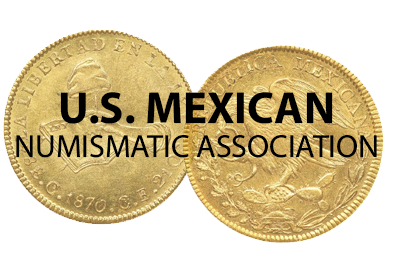S.J.N.G. AMERICA Half Real 1813
by Max A. Keech
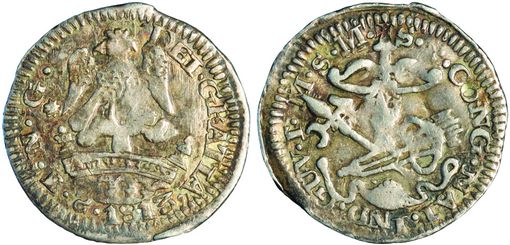
Summary: In September 1813 the Congress of Chilpancingo declared independence of the country it called America, renounced Ferdinand VII, and elected Father José María Morelos as its leader. In recognition of this declaration, the Supreme Junta National Government (S.J.N.G.) struck the historic S.J.N.G. AMERICA half real. For the first time the Insurgent government omitted a pledge of loyalty to Ferdinand VII on its coinage. The obverse legend declares S.J.N.G. DEI. GRATIA. in a bold break from the Monarchy. The importance of this issue cannot be overstated, and, to the author’s knowledge, this is the first time its attribution to the Insurgent’s declaration at Chilpancingo has been published.
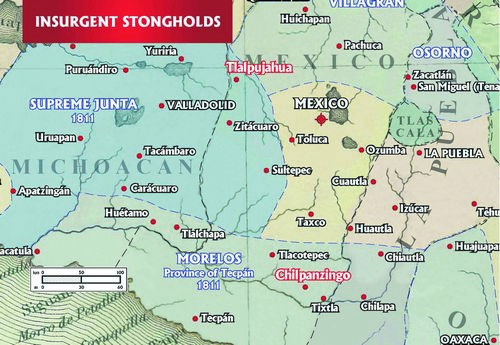
Congress of Chilpancingo: At the US Mexican Numismatic Association’s October 2024 convention, the author detailed the history of the Supreme Junta of America, which we abbreviate as the Supreme Junta, from its election at Zitácuaro in August 1811 through to its near demise by mid-1814. A seminal event in this history was the second Insurgent Congress organized by Father Morelos at Chilpancingo in September 1813. At this assembly, Morelos was elected leader of the Insurgent Government, replacing Supreme Junta President Ignacio López Rayón, and Junta members Liceaga and Verduzco. José María Morelos received the lifetime title Generalissimo.
Declaration of Independence: For the first time, Congress declared America an independent nation, free of Spain and Ferdinand VII. America, and Americano, were revolutionary terms used by the Insurgents to describe their land and themselves. Independence was outlined in article 1 of the draft constitution (Sentiments of the Nation) which states; “Que la América es libre independiente de España y de toda otra Nación, Gobierno o Monarquía…” (America is free and independent of Spain and all other nations, governments and monarchies...). This declaration was repeated shortly after in the related Declaration of Independence. America was the Insurgent Congress’ chosen name for their independent state! Morelos, over the objections of Ignacio López Rayón and a few others, was the prime advocate for this complete break with Spain and the Monarchy. The 1813 Chilpancingo Congress also eliminated all class distinctions and declared each citizen to be henceforth known by the term Americano! The numismatic result of these events included the coinage of this silver half real commemorating the Chilpancingo proclamations by prominently announcing the newly independent nation AMERICA across the deck of its bridge. The transfer of sovereignty from the Monarchy to the Supreme Junta National Government is clearly expressed with S.J.N.G. DEI. GRATIA., replacing the familiar legend VICE. FERD. VII. DEI. GRATIA. used on all previous coinage of the Supreme Junta from 1811-1813. Ferdinand VII by the grace of God is transformed to the Supreme Junta National Government by the grace of God! While we do not have documentary evidence of this commemorative thesis, the timing of these events, the naming of AMERICA in the draft constitution and in the Declaration of Independence, along with the creation of three different half reales proclaiming AMERICA in 1813 offers a compelling explanation.
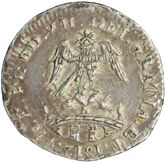
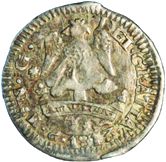
Supreme Junta Legends Before & After Chilpancingo

½ Reales Proclaiming America
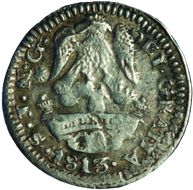
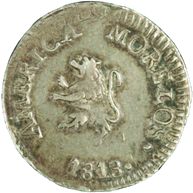
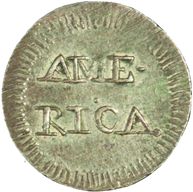

S.J.N.G. AMERICA AMERICA MORELOS AME-RICA
Proclaiming America: In addition to the S.J.N.G. AMERICA half real, two other half reales and a counterstamp declared AMERICA in their legends in 1813 following the Congress of Chilpancingo. In Oaxaca, the 1813 AMERICA MORELOS silver half real was issued following the Congress. In this case both the declaration of America and the election of Morelos as Generalissimo are celebrated. In an unknown location, a rare and previously unpublished silver half real was struck which proclaims AME-RICA. We know very little about this coinage, including who the issuing authority was. There is also a counterstamp which displays a crown and flag above a bridge emblazoned with AMERICA, another numismatic item likely commemorating the revolutionary proclamation of American independence at Chilpancingo. While it does not proclaim America, a related Supreme
Junta half real struck in Uruapan in late 1813, substituted the Supreme Congress for Ferdinand VII in its legend. The So.CONG.DEI.GRATIA. half real will be discussed in a future article.
Crown & Flag Counterstamp with AMERICA across its Bridge
S.J.N.G. AMERICA Design: The S.J.N.G. eagle is stylistically like the eagle on the NORTE counterstamp. It also displays a star to the left of the eagle. These similarities are not a coincidence. President Rayón’s brother, General Ramón López Rayón was responsible for the NORTE counterstamp in the period leading up to the September 1813 Congress of Chilpancingo as will be outlined in a future article on Insurgent counterstamps. At Chilpancingo, newly elected Generalissimo Morelos appointed Ramón López Rayón Commandant General of Tlalpujahua, just prior to issuance of the S.J.N.G. AMERICA half real in Tlalpujahua. On the reverse, the “T” (Tlalpujahua) mintmark confirms the 1813 S.J.N.G. AMERICA half real was struck in Tlalpujahua, simultaneously with the 1813 So.CONG.DEI.GRATIA. half real in Uruapan, confirming that the Insurgents had reoccupied Tlalpujahua after being forced out in May 1813. The denomination Mo (Medio) is added for the first time on a Supreme Junta half real. New lettering punches of a more refined style are utilized for the first time. These shared punches were used for both the 1813 Tlalpujahua S.J.N.G. AMERICA and 1813 Uruapan So.CONG. dies. Planchet quality is significantly improved from the preceding 1812-1813 Tlalpujahua half reales. The assayer reverts to S.M., the assayer on earlier Tlalpujahua coinage, with the assayer identified as T.L. now in Uruapan.
Also, for the first time on an Insurgent half real, a colonial style edge was attempted before striking. The application of a colonial edge met with limited success. S.J.N.G. AMERICA half reales are occasionally encountered with a bold colonial edge, but more often, examples have either a faint or almost undetectable colonial edge. Based on the timing of the Chilpancingo Congress, we can place the minting of the S.J.N.G. AMERICA half real around November- December 1813, following the 6 November Declaration of Independence. Two obverse dies and one reverse die are known, attesting to its brief minting period.
Prior Attributions: Krause does not list the Supreme Junta’s 1813 S.J.N.G. AMERICA half real. Aureo & Calicó list dates of 1811, 1812 and 1814, in addition to 1813. Only 1813 is known, although 1814 is a theoretical possibility.
Colonial Edge
Epilog: The 1813 S.J.N.G. AMERICA half real was the last silver coinage of the Supreme Junta. Together with the Uruapan copper half reales, they are the only Supreme Junta issues that omit a pledge of loyalty to the exiled King Ferdinand VII. Morelos’ ascension to leadership at Chilpancingo was short lived and by January 1814, Morelos relinquished power following a catastrophic military defeat at Valladolid. Following this defeat, the National Congress, under constant Royalist pursuit, relocated to Tlacotepec, Uruapan, Púturo, Tiripitio, Apatzingan and then Ario. Silver coinage was no longer struck but in early 1814 Insurgent forces in Uruapan struck copper half and two reales in the old Supreme Junta style by restoring the declaration VICE.FERD.VII. DEI.GRATIA.
Listing
S.J.N.G. AMERICA ½ Real 1813
The 1813 Supreme Junta S.J.N.G. AMERICA half real commemorates the Declaration of Independence by the Congress of Chilpancingo, where the country they called AMERICA, was declared free. AMERICA is prominently displayed across the bridge’s deck and the S.J.N.G. (Supreme Junta National Government) replaces Ferdinand VII as the declared sovereign in its legend.
| Obverse Design | S.J.N.G.DEI.GRATIA.1813. separated by an eagle on a nopal cactus surmounting a bridge declaring AMERICA, with a star in the left field. Only two obverse and one reverse die are known. The second obverse die has a retro S in S.J.N.G. creating an interesting variety |
| Reverse Design | +S.P.CONG.NAT.IND.GUV.T.Mo.SM (Supreme National Congress of the Independent Government). surrounds an upraised hand grasping a bow with arrows, quiver, spear and sling below. The denomination Mo (medio) is added for the first time on a Supreme Junta half real |
| Edge/Planchet | Examples with bold, weak and nearly non-existent colonial edges are found. Bold colonial edges should be considered premium examples. Planchets tend to be larger in diameter than the dies resulting in a raised outer rim on a portion of most examples. |
| Weight & Fineness | Weights vary but are generally from 1.55 to 1.75 grams. XRF testing indicates a silver fineness of 90% with trace amounts (0.2-0.5%) of gold and lead. Copper test above 99.5%. |
Struck Copper ½ Real
S.J.N.G. AMERICA
K280
K280 1813 T.S.M. The rare copper S.J.N.G. AMERICA half
real was struck from the same dies as the silver half real. Only a single example has been recorded but it is likely others exist.
Rarity Extremely Rare.
Struck Silver ½ Real
S.J.N.G. AMERICA
K281a K281b
K281 1813 T.S.M.
Rarity Quite Scarce with examples typically available in Fine to Very Fine condition. Higher grade examples are Rare. Examples with a fully readable AMERICA are Rare.
Varieties a. Standard S in S.J.N.G.
b. Retro S in S.J.N.G. Availability of this variety is roughly equivalent to the standard variety. This is not surprising given that all examples appear to come from just two obverse dies which share a common reverse die.
[Author’s note. This article is a chapter in a long-term War for Independence book project. I would like to thank Cory Frampton and Mike Dunigan for reviewing and providing invaluable comments and editing. Readers’ comments are always appreciated and can be emailed to
